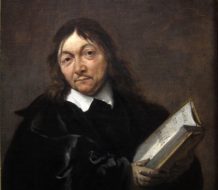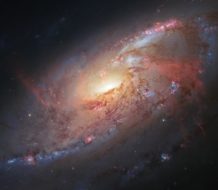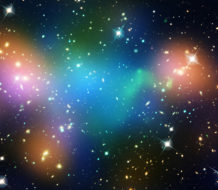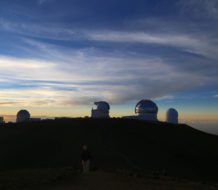The hope that science, and especially physics, might provide us with a complete and unified description of the universe has thus far been disappointed. In particular, there is to date no reconciliation of Einstein’s theory of general relativity and quantum physics. And yet, the physical sciences themselves have largely been immune to real crises for nearly a century. Doubts never seem to linger for long, quickly dispelled as they are by empirical results or new research programs. But the philosophical problems posed by physical science — and especially by quantum physics — for our fundamental understanding of the universe have been harder to let go.
Can physical reality be, at its most basic level, probabilistic? Is the act of observing quantum phenomena separable from the phenomena under observation? How can two distinct physical systems be entangled to such an extent that the behavior of one can affect that of another even across vast distances? Are quantum laws compatible with our classical understanding of causality, matter, and identity?
At midcentury, when philosophy of science became its own academic discipline, there was a sense that this new subfield might be able to, if not solve the philosophical problems posed by quantum physics, at least provide much needed conceptual clarification. That hope, too, has yet to be fully realized. Some scholars have become frustrated by all the attempts to get a philosophical grip on the quantum world. They eschew interpretation altogether, advising their colleagues to instead “shut up and calculate.”
Einstein famously captured the philosophical perturbation about the probabilistic universe apparently offered by quantum theory, when he said that “God does not play dice with the universe.” The quotation seems to imply that quantum reality should be just as disquieting for religion as it is for philosophy — that the strange, random, and entangled world of the very small is unworthy of an omniscient being.
Yet, from another point of view, the failure of both the sciences and philosophy to come to terms with quantum physics can be seen as a kind of victory for religion. Humankind’s finitude — our fundamental inability to fully grasp God and His creation — is, after all, a central tenet of Abrahamic religious thought. Perhaps it should not strike us as a surprise that, as we take technology-aided excursions from our medium-sized home into the worlds of the tiny and the distant, we become perplexed.
Einstein, albeit accidentally, captured this sentiment too when he dubbed Niels Bohr “the Talmudist” for his attempts to describe quantum theory’s assault on the classical understanding of the universe. Bohr responded to challenges to early quantum theory made by Einstein and others by moving the focus from ontology — the study of what there is — to epistemology — the study of what we can know. He emphasized the necessity of grasping the quantum realm through natural language and the concepts adapted to our intercourse with the everyday world. These concepts remain indispensable to the expression of scientific knowledge, though they contain implicit assumptions — for example, the separation of the means of observation from what is observed — that are undermined by what we know about the quantum world. Bohr believed the resulting paradoxes cannot be explained away but are evidence of human epistemic limitations.
Of Bohr, Einstein wrote to Erwin Schrödinger, “The Talmudist philosopher whistles at ‘reality’ as at a bogeyman of naiveté.” Although Einstein did not intend this reference to the intricate and scrupulous argumentation of the Jewish tradition as a compliment, it does suggest the possibility that, despite a history of conflict between science and religion, theological reasoning might yet have something to say about our understanding of the material world and our place in it.
Science and Reality
Exploring that possibility was the aim of a conference at the University of Notre Dame in April 2017. The conference, titled “The Quest for Consonance: Theology and the Natural Sciences,” was held in honor of Ernan McMullin, longtime professor of philosophy at Notre Dame, who died in 2011.
McMullin was a priest as well as a philosopher, and developed a theory of what Bas van Fraassen, in his opening talk, called a “nuanced” realism. McMullin and van Fraassen, two of their generation’s most esteemed philosophers of science, engaged in a decades-long debate over what is called realism in science. Van Fraassen favors an empiricism that regards scientific theories as constructed models with practical applications only. As to the question of whether a scientific theory identifies something real in the world, van Fraassen remains agnostic. When a scientific model begins to fail, we construct a new one that works better, but we ought to resist the temptation to think it offers something more, such as a true description of reality.
Opposed to this kind of empiricism is McMullin’s realism, which, as van Fraassen presented it in his talk, centers on the concept of “retroduction.” According to McMullin’s theory, science does not merely build useful models; it also makes inferences from perceived phenomena to causes lying behind (hence “retro-”) the phenomena. When Einstein’s general theory of relativity says space-time is curved, it’s because space-time really is curved — not just because relativistic models produce accurate predictions.
Crucially, McMullin’s retroduction is not the same as logical inference. Unlike the latter, retroduction is not rule-governed, but rather involves creativity and conceptual innovation on the part of the scientist. Einstein was not logically compelled to generate the general theory of relativity by empirical evidence alone; instead, he engaged in an “imaginative modification of existing concepts,” as van Fraassen put it, describing McMullin’s view. It does not follow that scientific theories give us something like objective, timeless truth, however. If they did, every scientific revolution would involve an upheaval of reality itself. Rather, McMullin thinks scientific theories offer “practical certainty” — conviction that is sufficient grounds for action.
At this point, it becomes difficult to see exactly what’s at stake in the debate between realism and empiricism, as a number of commenters at the conference noted. The “nuanced” realist says the scientific model points to a reality behind appearances, but is subject to later conceptual transformation and thus provides only practical certainty. The empiricist counters that all we have are the appearances and the model that proves useful in accounting for them. The word “real,” which divides the realist and the empiricist, begins to look like it does nothing more. To quote twentieth-century philosopher Ludwig Wittgenstein on idle philosophical language, we seem to be “turn[ing] a knob which looks as if it could be used to adjust something in the machine; but it [is] a mere ornament not connected with the mechanism at all.”
Might it be McMullin’s faith that assured him that science provides more than useful models, allowing him to make the leap to realism? No, said van Fraassen. Although McMullin thought his position more congenial to the believer than empiricism, he insisted it was neither determined nor required by faith.
But there may be something theological in McMullin’s view nevertheless: not his insistence that science is getting at reality, but his characterization of how it does so. The path from appearance to what lies behind it is, as McMullin puts it, “suggested, not implied.” This means that science calls for something like the poet’s creativity; it creates models that function like metaphors in poetry.
Good poetic metaphor, McMullin writes, does not compare “two already partly understood things,” but rather serves “to illuminate something that is not well understood in advance.” It allows us to see something new, or something old in a new way. Similarly, scientific models do not merely “match” the observable phenomena; they recast them. Mountains look different once you understand tectonic shift. Here, reality is conceived not as something lying there inert and passive — a corpse awaiting autopsy — but more like living nature that alternately resists and rewards our struggles to articulate it — less like reality, that is, and more like creation.
The Rationality of Traditions
The notion that scientists face a world like that of poets and theologians helps to reframe the debate over the rationality of science, which became urgent after the destabilizing work of Thomas Kuhn and other philosophers and historians of science beginning in the 1960s.
Their attempts to understand the historical development of science brought to the fore ideas like underdetermination and incommensurability. Underdetermination — the idea that the superiority of one scientific theory over another is not completely dictated by empirical evidence — seemed to challenge the rationality of science by consigning the choice between competing theories to sociological whim. And incommensurability — the idea that competing theories can be not just distinct ways of representing phenomena but wholly different ways of seeing the world — seemed to challenge the notion of scientific progress. For how can there be progress in science if successive theories seem not so much to be converging on the truth as continually displacing it?
But the problem here may lie with philosophy, not with science, as historian Peter Harrison suggested in his talk at the Notre Dame conference, “Is Consonance Always Preferable to Conflict?” Kuhn himself points out, responding to his critics, that the lesson of his work is not “that science is irrational, but that our notion of rationality needs adjustment here and there.” Nancey Murphy, a philosopher and theologian who also spoke at the conference, puts it this way: What Kuhn showed is not that science is irrational but “that the actual practices of scientists do not conform to an artificially imposed positivistic version of rationality.” It is only through the lens of a puerile conception of reason that paradigm shifts in science look irrational.
What conception of reason should we put in its place? Harrison’s answer drew on the work of renowned moral philosopher Alasdair MacIntyre’s notion of a “practice.” MacIntyre, himself a longtime member of the faculty at Notre Dame and now professor emeritus, famously criticized Enlightenment moral philosophy in his 1981 book After Virtue. Modern philosophers, MacIntyre argues, have detached moral language from the practices, narratives, and traditions that originally gave it meaning. They try in vain to give moral philosophy new foundations by appeal to such things as utility, individual feeling, and reason. But as the older moral practices have been weakened, not only by philosophical misunderstanding, but also by religious and political upheavals and economic depredations, the context in which moral language could be understood has also disappeared. To put it bluntly, moral theory now quibbles about the rules of a game that nobody plays anymore.
MacIntyre famously compares this moral catastrophe to a scientific one. He offers a thought experiment in which a great calamity has destroyed almost all of science’s key writings and experimental findings. Years later, well-meaning neophytes try to reconstruct scientific practice. But all they can generate out of the charred fragments that remain is a confused and arcane discourse that bears only a superficial resemblance to the real thing. They turn a knob and gawk at the machine, but nothing happens.
The analogy between scientific practice and moral practice runs deep in MacIntyre’s writings, as Harrison brought out in his talk. Science, of course, hasn’t been destroyed. But philosophy does generate a warped understanding of science by ignoring the latter’s status as a particular historical tradition. Although science presents its findings in ahistorical terms, “scientific reason turns out to be subordinate to, and intelligible only in terms of, historical reason,” MacIntyre writes. That is, science has its own history, with its own set of core beliefs and practices, in terms of which its practitioners judge the successes and failures of particular theories or paradigms. Thus, MacIntyre thinks that Kuhn’s critics — and even Kuhn himself — all miss the crucial factor right under their noses: There is an underlying “historical continuity which makes their own intelligible narratives” about science “possible” in the first place.
Consider the fundamental difference between the kind of paradigm shift at issue in debates over the rationality of science and the catastrophe imagined in After Virtue. The former involves the displacement of one scientific theory by another; the latter fells science as a tradition. If paradigm shifts were as drastic as that, we wouldn’t be able to understand them at all. The very construction of a narrative about how Einstein succeeded where Newton fell short is evidence that incommensurability between one theory and another can only take place against the background of broader continuity within a tradition. Einstein might displace Newton; but both are engaged in science. MacIntyre suggests that scientific concepts, like moral virtues, come to life only in relation to the problems they confront, the goals they pursue, and, ultimately, the historically conditioned ideals they rely on.
Philosophy’s failure to grasp science as a historical tradition is, perhaps, unsurprising. The positivistic philosophy that fails to give us a clear picture of scientific practice grew out of the attempt to make philosophy more scientific. But, like most things, science does not do a very good job of understanding itself. Harrison framed the problem as a failure of philosophy in general; it might be better construed as a failure of a particular self-understanding of philosophy — a failure to maintain its critical independence of scientific practice.
Indeed, the MacIntyrean solution suggested by Harrison is a philosophical solution. “The theory of scientific rationality has to be embedded in a philosophy of history,” MacIntyre writes. It is not enough merely to tell a story about how one scientific paradigm ends and another begins; we have to notice that we are telling such stories and what scientific ideals we appeal to in doing so. It is these ideals which allow for productive rational debate during periods of scientific upheaval, just as adherents of different political or religious traditions engage in such debate within well-functioning pluralistic societies.
Conflict and the Limits of Tradition
MacIntyre’s insights into the historical nature of science and McMullin’s insights into its creative character place science in the broader context of human discursive practice. They thereby provide a framework for understanding how religion and science can be considered separate traditions that nevertheless remain consonant in some sense. “Consonance” here does not necessarily imply a shared understanding of reality, but rather a kind of methodological compatibility. It points not to agreement on basic truths, but a shared sense of the limits of what we can know — a humility that can prevent error and prove productive for both traditions.
These themes were taken up in Menachem Fisch’s talk on discursive practices in the Talmud and the lessons they might teach science. Fisch, a historian and philosopher of science as well as a scholar of the Talmud at Tel Aviv University, opened his talk by identifying a lacuna in Kuhn’s description of paradigm shifts. Kuhn’s focus on the moment of “conversion” (Kuhn’s word) from one paradigm to another — the scales falling from the scientist’s eyes and the phenomena appearing in a new light — leaves something essential unaccounted for: “the rational incentives” that lead scientists to look for a new framework in the first place. Ignoring these incentives can make the paradigm shift look irrational. Wholesale conversion seems to imply that rationality itself is dependent on a particular scientific paradigm and will go missing when one paradigm yields to another. While Harrison approached this problem through the historical narrative that must underlie paradigm shifts, Fisch focused on the external destabilizing forces that can provoke scientific crises in the first place.
Fisch’s talk centered on a portion of the Talmud that recounts disputes between the rabbinic houses of Hillel and Shammai in the first centuries BC and AD over their respective interpretation of the halakhah, or Jewish religious law. In the Talmud, this discord is offered in preference to the method of Rabbi Meir, a sage interpreter who does not engage an interlocutor, but instead marshals arguments on all sides of a given issue before settling on one. After three years of unresolved debate between Beth Hillel and Beth Shammai, the Talmud states:
A heavenly voice issued forth announcing, “Both these and these [each house’s interpretations] are the words of the living God, but the halakhah is [ruled] according to Beth Hillel.” Since, however, both are the words of the living God what entitled Beth Hillel to have the halakhah decided according to them? Because they were kindly and humble [literally “willing to be insulted”], and they not only studied their own rulings with those of Beth Shammai, but gave their rival’s arguments precedence over their own.
Fisch drew several lessons from this text. First, the Talmud prefers the real challenges offered in the debate between Hillel and Shammai to Meir’s hermetic self-criticism, which, despite its brilliance, fetishizes argument and threatens to devolve into sophistry. Second, it prefers the humility and malleability of the Hillelites, who were willing to adopt the Shammaite position in certain cases, to the traditionalism of the Shammaites, who give Hillelite views no reciprocal hearing. But this traditionalism does not prevent the Shammaite interpretations from being granted the status “the words of the living God.” Indeed, the legitimacy of the Shammaite school is a condition for the ultimate superiority of the Hillelite school, since it is only in conflict with the Shammaite school that Hillelite thought can be genuinely strengthened.
Here Fisch drew a distinction between diversity and pluralism, which helps clarify his broader point about the possibility of consonance between theology and science. The outsider’s view is not one to be merely tolerated or admired for the bare diversity it offers. With real pluralism, the value of the outsider’s view lies in its opposition. Unless it is regarded as a legitimate competitor — a point of view that might win out and be adopted in preference to one’s own — the outsider’s view is nothing more than decoration.
The Hillelite position entails a radically different understanding of tradition itself, according to Fisch. “When the Hillelites are convinced to abandon a tradition in favor of that of the Shammaites, it is not their understanding of it that is criticized and modified but the tradition itself.” It is “not a question of them getting the good word right but of seriously asking if the good word is right.”
This model of pluralism, Fisch suggested, can offer an example for science. Although science at times goes through periods of crisis where a given tradition is forced to consider alternatives seriously, it does not actively seek to be destabilized — or “ambivilated,” to use Fisch’s term — like the Hillelites do. Self-criticism is not enough. To enrich one’s own tradition — to be truly faithful to it — one must be willing to leave it behind, at least momentarily, so that it can be seen from without.
Consonance as Self-Knowledge
What does this mean for the relationship between science and religion? The view of consonance that emerges advocates neither separation nor subordination. Science and religion should not simply respect the other’s domain from a distance, nor should one try to assimilate the other’s understanding of reality to its own. The former model ignores the mutual enrichment that can result from conflict. Traditions come into their own by dealing with the obstacles, disputes, and paradoxes that arise from confronting and inhabiting rival points of view. The latter model goes to the other extreme by absolutizing one discourse and applying it to phenomena it was never meant to explain.
Consider, for example, the new atheist and the fundamentalist. They share an absolutism that imposes the language of a given tradition on the world at large. “God probably doesn’t exist” is a favorite claim of new atheists. The word “probably” and its pretense to objectivity makes it clear that we are in a discourse where it is absurd to speak of faith. The universe does not play dice with God. This is the same kind of error of context creationism makes when it looks for scientific evidence to support the story of Genesis. In each case, one tradition attempts to absorb the other but ends up distorting itself.
Instead of expanding one’s own tradition to encompass others, we should, as the Hillelite example counsels, engage with opposing points of view in order to see the limits of our own — in order to see ourselves, to the extent possible, as adherents of a particular tradition. What the pre-Socratic philosopher Thales said of individuals — “the most difficult thing is to know yourself” — can thus be said of whole traditions as well. Ironically, believing the basic tenets of a given tradition, whether scientific or religious, can be a barrier to understanding them. These barriers are only absolute, however, where they go unrecognized.
Thus viewed, the conflict between science and religion should not be extinguished, but rather, in a certain sense, stoked. Consonance lies not in a single, settled perspective, but in refusing to settle, constantly shifting and modifying one’s perspective in an attempt to overcome — to the extent possible — the limitations of one’s own tradition.











